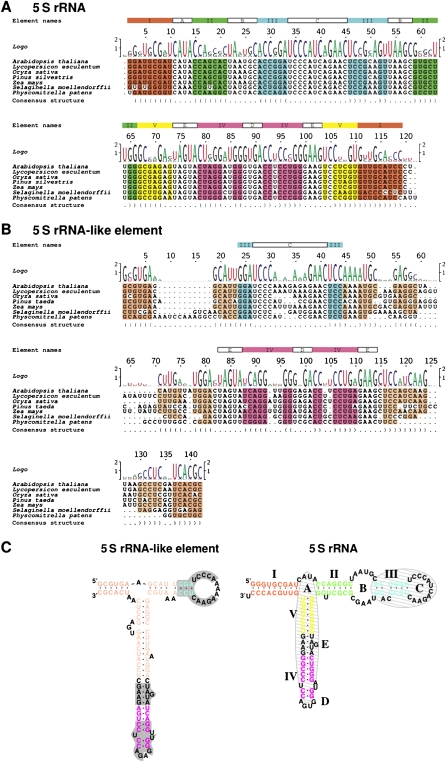Figure 2.
Identification of a 5S-rRNA-like cis-element that coincides with the conserved cassette exon AS event. For clarity, only those sequences corresponding to the ECR in seven plant species representing evolutionarily significant nodes from Bryophyta to Magnoliophyta were displayed (for complete alignments see Supplemental Fig. 2). Alignments are based on 49 5S rRNA (A) and 52 5S-rRNA-like element sequences (B). (C) Similarity between the predicted secondary structure of the 5S-rRNA-like element of AtTFIIIA (left) and 5S rRNA (right). Element names are given according to the standard 5S rRNA nomenclature: Helices are designated by roman numbers (I, II, III, IV, and V) in colored boxes; loop regions are designated by letters (A, B, C, D, and E) in open boxes. Helical regions, which belong together, are colored identically in the element line, in the alignment, and in the structure models; similar colors are used to emphasize features similar in 5S rRNA and the 5S-rRNA-like element. In lines labeled “Logo,” the size of nucleotide characters is proportional to the frequency of occurrence of this nucleotide at this position; the height of the character stack signifies the information content (in bits) of the sequences at that position (Beitz 2000). The last line of the alignments shows the predicted consensus structure in bracket-dot notation (Wilm et al. 2008). In the structure model of 5S rRNA, binding sites of TFIIIA and ribosomal protein L5 are shaded in gray. In the structure model of the 5S-rRNA-like element, sequence regions identical in 5S rRNA and the 5S-rRNA-like element are highlighted in gray.

